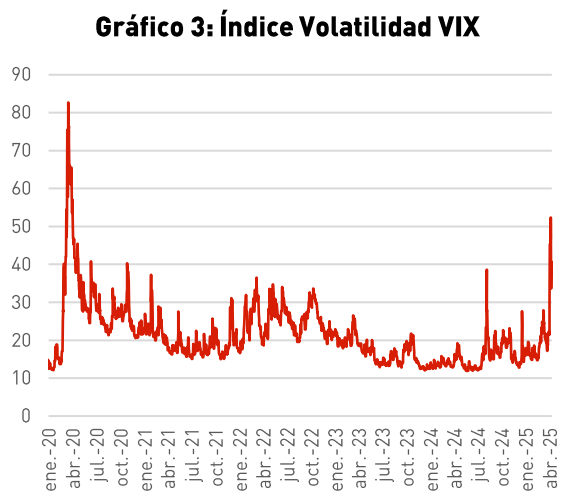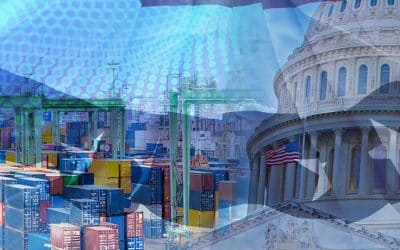High volatility in stock markets: why it happens and how to act

Redacción Mapfre
In recent weeks, international markets have faced their most challenging period since 2020. In a situation marked by surging volatility, emotions like fear take center stage in the minds of many investors, and market movements shift from linear to exponential. Such situations, although not frequent, do tend to recur periodically, and it’s important not to get swept up in the negative atmosphere or act impulsively with a short-term mindset, as the experts at MAPFRE remind us.
The trigger for this market turmoil was the announcement of global tariffs on Donald Trump’s so-called “Liberation Day.” However, the erratic swings that followed from the US president after April 2 led to days of heavy losses, with only brief surges of optimism. Once the initial smoke from Trump’s first burst of tariffs cleared, red numbers spread across virtually all regions and asset classes.
Uncertainty encourages downward movements
Why does the stock market behave like this? Daniel Sancho, Director of Investments at MAPFRE Gestión Patrimonial, gives a very direct explanation: “short-term markets are schizophrenic. They receive one piece of bad news after another, and that causes uncertainty, which is probably what hurts the markets the most.” He adds: “The markets are scared, and they are scared because they don't understand what is happening. The volatility and little certainty we have mean that the market will go crazy in the short term.”
To illustrate how uncertainty lies at the heart of market disruptions, Sancho contrasts Trump’s tariffs with other announcements such as changes in monetary policy. These can have an even greater impact on macroeconomic variables and may also trigger volatility—but generally far less than what we’re seeing now—because central banks aim to be predictable and avoid sudden shifts in their messaging. “Uncertainty is the enemy of stability,” Sancho summarizes; stability is the key condition for investments to thrive.
The following chart shows the evolution of the VIX index, which measures market volatility based on asset price fluctuations, specifically in the U.S. market. It highlights key spikes: the COVID-19 peak, a surge in 2022 following the invasion of Ukraine, and the most recent rise driven by tariff-related tensions. All of these episodes share one defining feature: high volatility. That's why the VIX is also known as the “fear index.”

In addition to the underlying causes driving these market stampedes, there are also technical factors at play. Professional investors typically operate with risk management systems that, once an asset reaches a certain level of decline, trigger automatic sell orders to limit losses. While this is a technical and automatic mechanism, it adds to the snowball effect during episodes of heightened volatility.
We must also count on the current concentration of stock market indices. In the US—specifically in the S&P 500, one of the key benchmarks that includes the 500 largest publicly traded companies in the country—the tech giants known as the ‘Magnificent 7’ (Alphabet, Amazon, Apple, Meta, Microsoft, Nvidia, and Tesla) make up around 25% of the index. This means that any movement in these stocks has a significant impact on the overall index. Moreover, their shares had seen substantial gains in recent years.
What to do in these cases?
For the average investor, with a saver profile, who does not need money in the short term, the best formula is to wait. Alberto Matellán, General Manager of La Financière Responsable, recommends not to be guided by the “negative headlines” that tend to multiply when charts plunge abruptly. It’s worth remembering that “there have been many moments of volatility, many major storms, and there will be many more, but we’ve come through all of them.” In fact, he asserts the role of active management and points out that from these crises, managers have historically emerged “more resilient or even better off.”
Along the same lines, Daniel Sancho points out that in episodes of volatility the stock market usually behaves “like a pendulum” and large declines at some point are followed by rebounds. “It is vital to bear this in mind at this time: the situation will be temporary, three months or three years, but it will pass. It's a matter of time,” says the director of MAPFRE Gestión Patrimonial.
With this in mind, investors must control their emotions, which is not easy when days of massive losses take place. But selling at the lowest time can be a very bad decision that weighs down the profitability of a portfolio for years.
Eliminating this emotional bias is one situation in which having an adviser can make a difference. “An adviser can talk to a customer and make them see that the last thing they should do is sell. And they can make a lot of money with that advice alone. Many people make adjustments at the worst possible moments, and the loss in returns can be dramatic,” explains Sancho, who highlights the value of financial advisors even during bullish periods—when markets may be rising in an “irrational” way and professionals can step in to make adjustments and rebalance portfolios.
Another important point to keep in mind during market turbulence is the investment horizon. If an investor has defined a specific time frame (usually several years) based on personal circumstances, there’s no reason to change course because of a temporary drop. Most likely, by the time the investment period comes to an end, the portfolio will have recovered to much higher levels.



